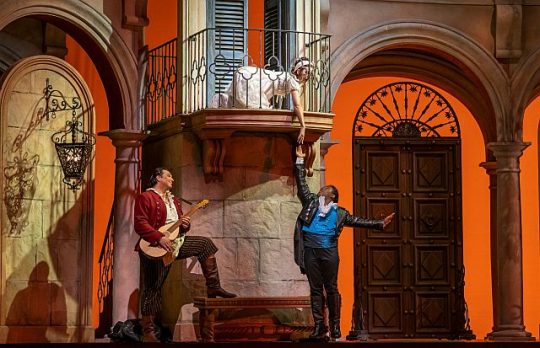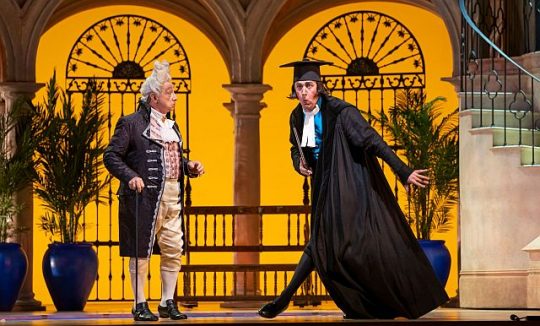
3 ½ stars
What a joy to see and hear an opera that pokes fun at opera but does so using top tier voices and leads who know how to act.
And so Lyric Opera of Chicago opened its 2019-20 season with Gioachino Rossini’s “The Barber of Seville,” a wildly popular opera buffa.
After first debuting as “Almaviva, o sia L’inutile precauzione” in 1816 in Rome, the opera took on the title of The Barber of Seville, or the Useless Precaution” with an Italian libretto by Cesare Sterbini that is based on the 1975 comedy in French playwright Pierre Beaumarchais’ trilogy.
Presented as a Rob Ashford production with a revival under the direction of Tara Faircloth, the scenes move from one delightful, chuckle moment to the next beginning with when Figaro has trouble getting rid of musicians asked to help Count Almaviva serenade the beautiful Rosina to when Almaviva and Rosina try to touch fingers in the balcony scene.
Czech bass-baritone Adam Pachetka now must own the role of Figaro after starting the opera with a brilliant “Largo al factotum della citta” in the aria’s challenging triplets, fast (6/8) time.
Award winning American tenor Lawrence Brownlee does a hysterical Almaviva, disguised as Lindoro, an ardent but poor lover, disguised as a drunk soldier, disguised as a singing tutor/priest.
But funny as they are none of the disguises hide Brownlee’s talent ranging from the simple cavatina bel canto “Ecco, ridente in cielo” serenade and the duet with Figaro: “All’idea di quel metallo” (think gold), to his duet with Rosina, “Dunque io son…tu non m’inganni?”
Rosina, the ward of Dr. Bartolo who wants to marry her for her dowry, was originally written for a contralto but opera houses have generally changed it to a mezzo-soprano role which in the current Lyric production is sung by French mezzo-soprano Marianne Crebassa.
She was last seen at the Lyric as Dorabella in “Cosi fan tutte,” another role that matches perfectly with her charming, comedic acting ability. Crebassa does a nice cavatina “Una voce poco fa” with a couple of extra cadenzas.

Actually, lots of cadenzas are added to all the arias and duets which, although sung beautifully, is part of the fun Rossini pokes at operas.
Their expressions of love and extra cadenzas between Almaviva and Rosina delay their elopement long enough for the ladder to be removed from the balcony even though Figaro keeps trying to move them along.
Dr. Bartolo, the mean-spirited but comic figure everyone would likely boo if they weren’t polite, is perfectly portrayed by Italian baritone Alessandro Corbelli. He sings the aria “A un dottor della mia sorte,” with aplomb as he berates Rosina for trying to trick him.
His comrade in his schemes to marry Rosina is her music teacher, the comic Don Basilio, sung by Polish bass Krzysztof Bączyk in his American operatic debut. In the aria, “La calunnia è un venticello,” he suggests getting the count out of the way by embarrassing him with rumors.
Scott Pask’s set design works well on the Lyric’s stage and Catherine Zuber’s fine costumes nicely set the period. But Howard Harrison’s atmospheric lighting such as in the “Cold and still, just like a statue” scene (“Fredda ed immobile, come una statua”) sung by Pachetka, was an inspired touch.
That wigs, done by Sarah Hatten, wigaster and makeup designer, were important to this work, came across in the opera’s clever, sketch imprinted curtain.
Pulling it all together, however, is Lyric Music Director/Conductor Sir Andrew Davis and the Lyric Opera Orchestra who understand that timing is everything in a comedic opera. (Stefano Sarzani conducts Oct. 18)
DETAILS: “The Barber of Seville” is at the Lyric Opera House, 20 N. Wacker Dr., Chicago, Ithrough Oct. 27, 2019. Running time: about 3 hours, 5 minutes with one intermission. For tickets and other information call (312) 827-5600 and visit Lyric Opera.
Jodie Jacobs
For more shows visit Theatre in Chicago
